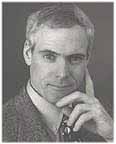James C. Collins loves to tell the story of Darwin E. Smith, someone most readers have probably never heard of. As Smith was ending two decades at the helm of Kimberly-Clark, maker of Kleenex and other personal-use paper products, he was asked what had driven him, what had he done to make his company so successful over time. “I was just trying to become qualified for the job,” Collins quotes Smith as saying. Smith’s statement is at the heart of Collins’ latest management study, which finds that leaders of great companies have genuine humility and self-doubt but also the singular drive to make their companies succeed. The author of Built to Last: Successful Habits of Visionary Companies (HarperBusiness, 1994), Collins spoke earlier this month at the fifth annual Wharton Leadership Conference entitled “Developing Leaders.” He focused his remarks on his new study, which will be published in the fall as Good to Great (HarperBusiness). Collins, a former Stanford Business School professor now based in Boulder, Colo., and his 22-person research staff spent four years trying to determine what made companies grow from merely good organizations to great ones and what sorts of leaders were responsible for that transition. Early on in the process, he took as a premise that goodness was anathema to greatness. “Good is the enemy of great and is why so many things don’t become great,” he said. “We don’t have really great schools because we have good schools. We don’t have great companies because we have so many good ones. And when we look back over a life and see if it is a great one, we don’t see many because it is just so easy to settle for a good one.” In Built to Last, he said, he and co-author Jerry I. Porras looked at how to build an enduring, and great, company from the ground up. The research for Good to Great was a bit different; Collins sought a standard that would allow him to look empirically at the question of how a decent company could become a great one. He took as his standard the enduring success of General Electric. Over the last 15 years, GE has beaten the market performance by 2.8-to-1. Other companies may have done better, but GE has done well consistently and its reputation for excellence is secure. So Collins and his researchers went to look for Fortune 500 companies that had sustained mediocre performances for 15 years or more but then experienced significant turnarounds where they outperformed the 2.8-to-1 GE standard. Of the 1,435 companies that appeared on the Fortune 500 listings at any time between 1965 and 1995, only 11 made the cut. “If there was something in the genetics of a good executive, it had to be in this group,” said Collins. “The goal then was to understand what was inside this black box.” One of the companies, he said, was a real surprise: Walgreen’s. After 40 years of underperforming, Walgreen’s turned a huge corner in 1975. If you had invested in Walgreen’s in 1975, Collins said, you would have beaten Intel by a two-to-one margin; Coca-Cola by eight-to-one, and the market as a whole by 15-to-1. “If we had found Cisco, then people would say, ‘So what?’” said Collins. “But a dowdy company like Walgreen’s gives us all the hope that we can do it too.” Collins’ research came up with other similarly dowdy companies, including Kimberly-Clark, Abbott Laboratories and Nucor. Collins said he searched in vain for similarities, until his researchers convinced him that a certain type of leadership was the core element in each of the organizations. Collins, however, generally considered himself “a leadership agnostic. I had begun by telling the research team that we wouldn’t have a leadership answer to our question. Leadership has become our all-purpose answer for everything we don’t understand about business. In the 1500s, we had another answer to unresolved questions. If there was an earthquake, we didn’t know how it happened, so we said, ‘God did it.’ The plague? ‘God did it.’” Then, he said, scientific breakthroughs made us realize that earthquakes were caused by seismic shifts and plagues by epidemiological consequences. “But in management, we are still in the Dark Ages and our answer always seems to be ‘leadership.’” Although he attributes other factors to the companies’ greatness – the culture of discipline, confronting previous failure and harnessing the proper technology, for example – the “leadership agnostic” in Collins has come to believe there is something about a certain type of leader that can drive a good company to greatness. He calls that combination of complex and sometimes contradictory traits of humility and internal drive ‘Level 5 leadership,’ the top form on his hierarchy of management personal attributes. Collins said most of the general public, and even business leaders themselves, would probably not know the names of the 11 CEOs who turned their companies from good to great. Kimberly-Clark’s Smith, who was never even profiled by the Wall Street Journal in his 20 years of leadership, was a primary example. Others included Ken Iverson at Nucor, Alan L. Wurtzel at Circuit City and George Cain at Abbott. In fact, he said, the prominence of Level 5 executives is cut off by those he calls Level 4 types – people who do have effective leadership skills, but are often more committed to self-aggrandizement than the sustained future of the institution. He likes to cite Lee Iacocca as a prominent example of a Level 4 executive. Iacocca, he said, did improve the fate of Chrysler while he was chief executive, but he never completed a long-term vision for the company. The company no longer exists as an independent entity. Chrysler, Collins notes, is an example of “good-to-great-to-imploding” – a much more common example than sustained good-to-great. Iacocca had a large personality, Collins said. His autobiography came out relatively early in life and was filled with personal, not organizational, self-praise. Yet he is commonly thought of as a business icon. Only one of Collins’ 11 “Good to Great” executives wrote an autobiography, and even that was entitled I’m A Lucky Guy. “We looked at a factor we called the Window and the Mirror,” he said, noting that Level 5 executives tended to look in the mirror and blame themselves for mistakes. But when things were good, they would look out the window and either proclaim how everyone in the company was wonderful or how factors of fortune caused success. When he asked Circuit City’s Wurtzel about his company’s success, Wurtzel replied that 80 to 100% of it was that “the wind was at our backs.” Collins faxed him charts showing how much better his company did than others in the field. “I told him they all had the same wind,” said Collins. “‘Gee,’ was his response. ‘We must have been really lucky.’” Yet most people don’t appreciate how lucky they are to have Level 5s among them. “We live in a culture that doesn’t pick Level 5s as subjects of admiration,” said Collins. “We pay attention to the 4s.” And that’s unfortunate for the business world, as well as the world at large. It’s important, Collins added, not to settle just for good leadership, but to strive in every field for greatness. “Think about it. Who was the last Level 5 President the U.S. has had?” he asked. Answer: Abraham Lincoln. “He was reserved, awkward, gangly and had personal humility.” But he had a goal of preserving the union, Collins said, even if 600,000 people, including himself, had to die to accomplish that.
Looking for more insights?
Sign up to stay informed about our latest article releases.



